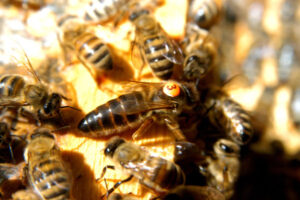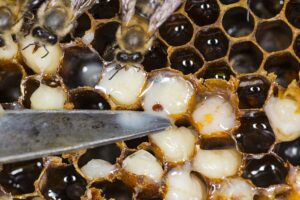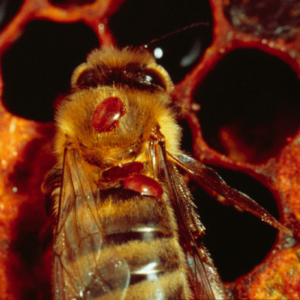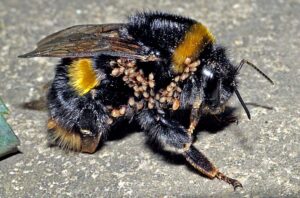Ankle biter bees. At first I just thought that these offerings were palp from the nuc suppliers to describe nasty, ornery bees or perhaps those with some Russian background. Or maybe leftovers of those feral black bees I remember in Santa Cruz County back in the 70’s.
 |
That is not the case. Actually these ankle-biters are a honey bee with great pedigree and complex genetic background. They were developed at Purdue University after beekeepers noticed that some of their colony honey bees bit the legs off dislodged varroa mites. ‘Bees from these colonies were chosen and inbred in order to increase the incidence of the genetic alleles that produced the behavior.’ More background information. |
The result of this breeding program yielded the so-called ankle-biters. The full story, however, reveals some issues, esp. in that these are traits involve complicated inbreeding which will dissipate with each generation. New queens as with Saskatraz or Caucasian will need to be reintroduced every few years.
‘The traits of this bee are usually the result of double recessive genes, which means inbreeding is necessary to make the trait appear. After inbreeding repeatedly and selecting for the desired traits, special queens—called breeder queens—are instrumentally inseminated from populations of drones that also carry the gene.’
Lots of good press but is there a silver bullet to this tale? I say this as there isn’t a silver bullet that works everywhere, for everybody or for every purpose. Generally I suggest get the best local queen(s) you can and enjoy the journey. In the meanwhile watch this this video of Ankle biters taken on hive beetles If this doesn’t perk your interest nothing will.
FINALLY!!! If black faced hornets or Japanese Killer wasps can chew off heads or slaughter my bees I expect my bees to defend themselves. They do have mandibles after all. Knowing that there are natural hygienic bees in development gives me great hope as while it is bad enough that the mites cannibalize the mites and their larvae, equally bad is the deformed wing virus (DWV) they spread to bees. A significant mite infestation near always will lead to the death of a colony, usually in the late fall through early spring.
But where are the testimonials out there? The feedback loop?. Are they equally aggressive to the beekeeper and the neighborhood? That they rob like Italians seems to be a given. The ability to bite mites is only one part of the equation and I suspect that Oxalic acid treatments will still need to be made.
Monthly sugar dustings with essential oils may be another treatment, if done on both sides of every comb, something the bees get a bit testy about. Shaking sugar from the top and sweeping it down with a brush is not going to have a great effect.
How defensive they might be against the Japanese Hornet or black faced wasps is another matter. Or against the beekeeper!
Personally I would agree with some studies that suggest that these and feral bee populations do better on the Varroa than do DNA limited packaged bees.
Here are a few testimonials/commentary – they vary greatly!
1, “Mites on the bottom board show physical damage. They brood up early compared to my other bees. I overwintered them all in 2 medium hive bodies with a mouse guard and a inner cover. They are good bees.”
2. “Purdue is doing a ton of research on the bees they have. 125 colonies. They have not treated for mites in 7 or 8 years. They have losses. The bees make a good honey crop and generally shut down at our dearth.”
3. “Many of the folks coming to get these stocks are phonies and I wouldn’t believe much they say. I can tell you that these same bees do great with minimal mite treatments and are successful at getting in to 7 frame contracts in almonds.”
4. My own experience is at the bottom of the page.
and a CON!
1, “Purdue Ankle Biter bees like to rob from dying neighborhood hives that had been infested with varroa mites, and then would bring mites back to their hive where the virulent mites would destroy the hive. I had been doing sugar shake tests about every 6 weeks or so and what I’ve learned the hard way, is that during robbing season that’s not often enough to test. I spent about 8 weeks trying to recover this hive with no success.
“This hive was one of the new breeds that dealt with varroa well. At the peak this summer, with no treatments, they never got above about 2 varroa/100 bees. So, seeing the hive taken out by a varroa bomb was really disheartening. In talking to or listening to other beekeepers who have had similar experiences, I’m not sure what can be done once a hive has been Varroa bombed. In the future, I’ll test more often, cage the queen to break the brood cycle, and use formic acid at the start. …”
 |
 |
 |
So if any of you have had experience with this breed please let me know in comments. I am getting my Queen and a frame of brood from Stanwood Bee Company in Washington. |
My own testimonial is a bit on the negative side as this hive was not as manageable as others and swarmed out on me twice. This may have been my own mismanagement but I have had better luck with my Carniolans and Saskatraz. I am also experimenting with a new Randy Oliver hybrid called GOLDEN WEST.” Read about these at this suppliers site!

I take my enthusiasm for the Ankle Biters back. The Ankle Biter strain seems to be very attack prone and not just defensively. They attack for no reason and chase. The question to be asked about any hive attacking is the WHY! and if they pursue the attack. A friend commented his own worry about people getting Africanized genetics (hybrids from all this “breeding” we insist upon – especially California stock). If just being moody, they might relax after things calm down and they get the lay of the land. The other issue being is did the nuc have a viable queen or is she out of action? More to the point is that this was supposedly a 2023 queen and I had wondered how she could have been fertile unless brought up from CA. The more frightening part is they go for the face, ears and eyes.
I was sitting some 8 feet away, making no movements just observing. All the other hives allow me to do this. The hive does have a good number of drones as well as active foragers. Another person just watching from some 20 feet away was also attacked and chased a few days back.